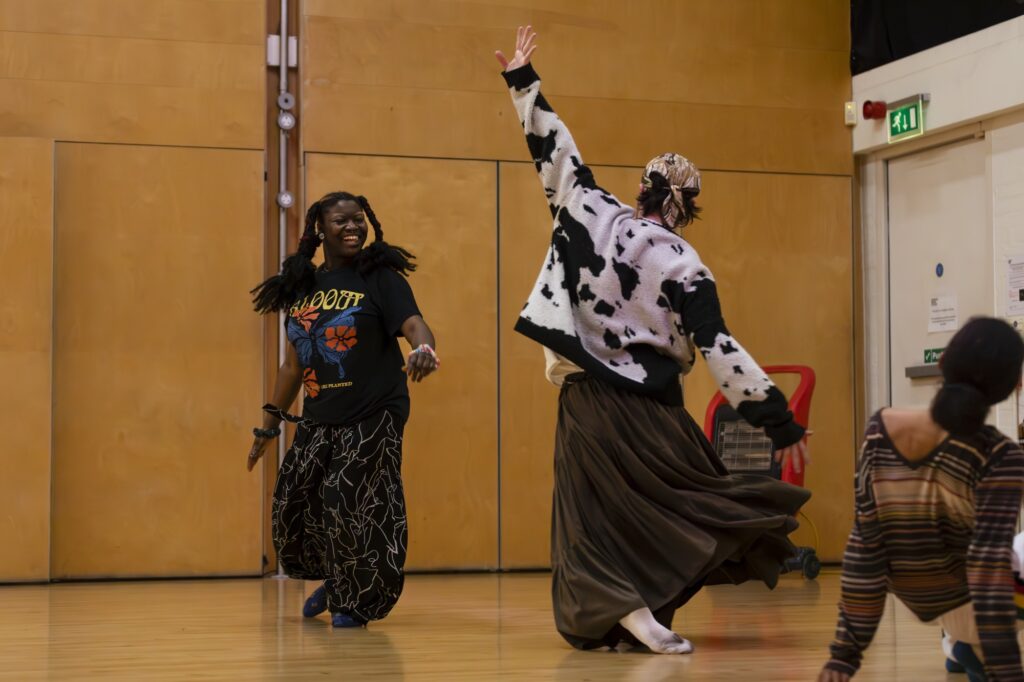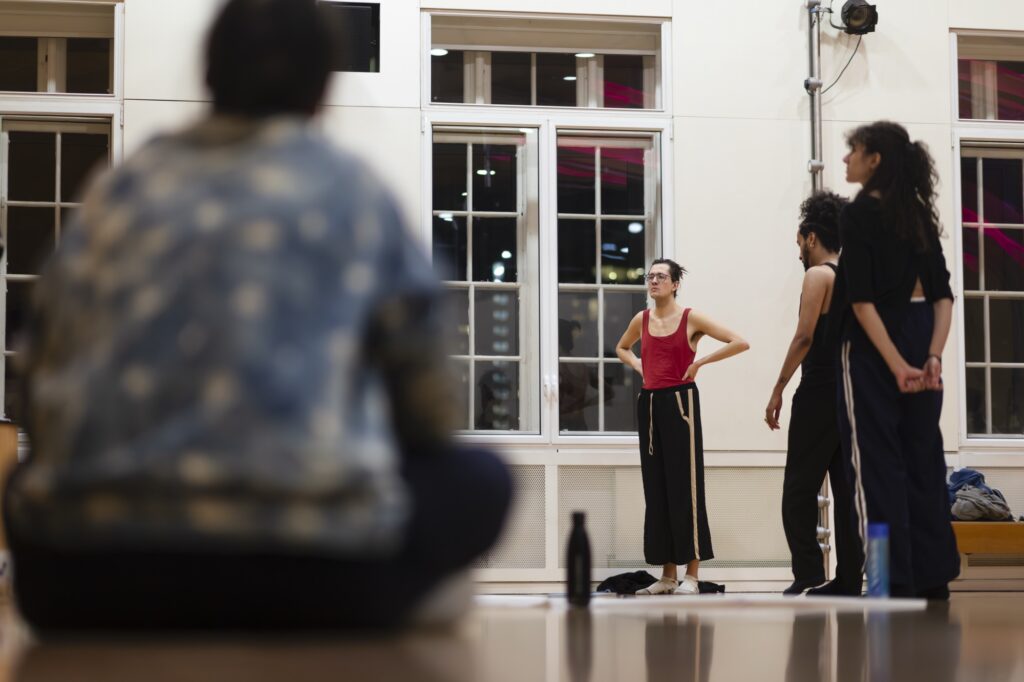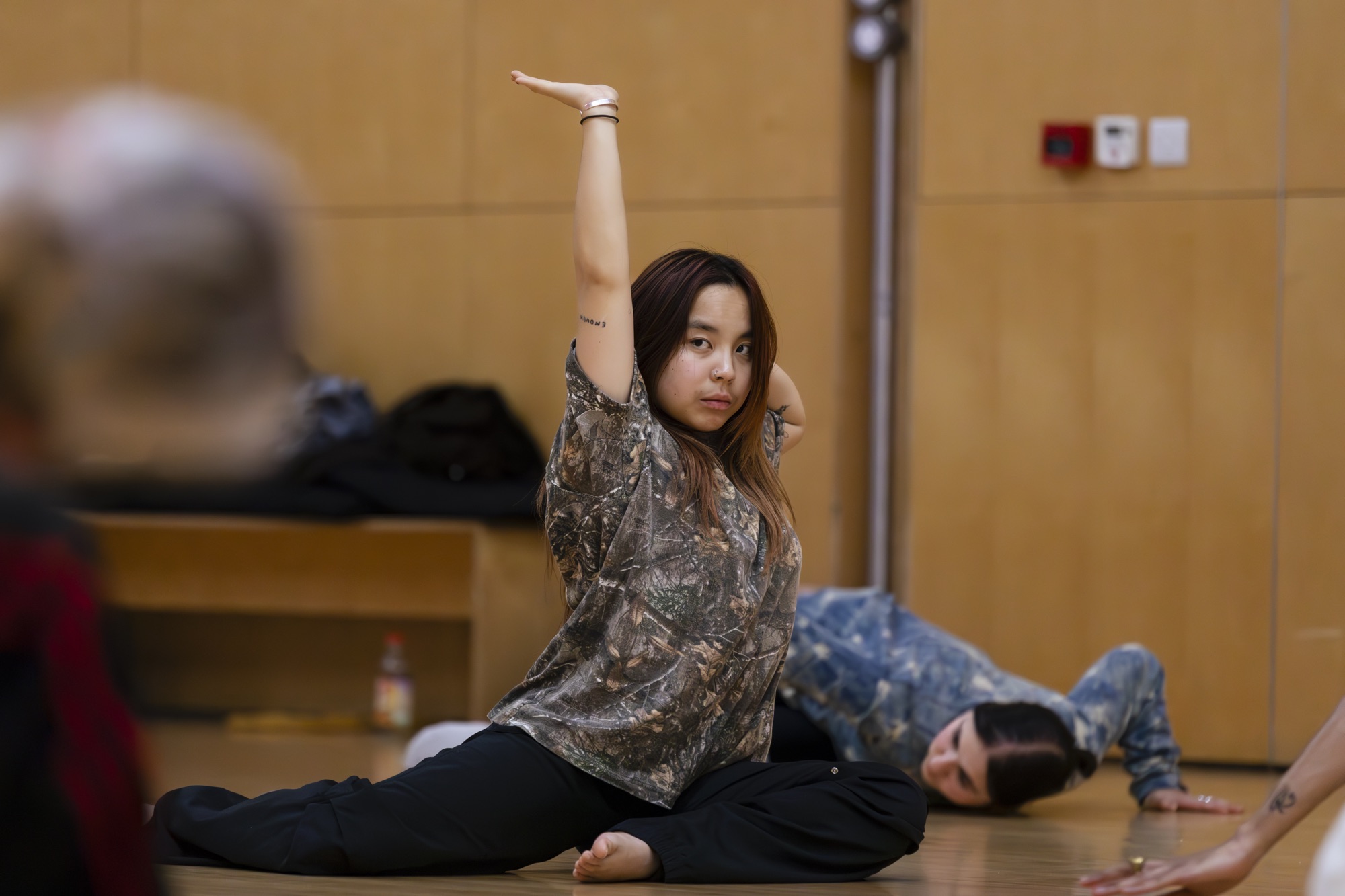Words by Maria Elena Ricci.
Last week I sat down to have a chat with Lena Hannigan, Maxi Himpe and Jemima TheRese Nzinga who are part of this year’s Siobhan Davies Studios’ NEXT Choreography cohort. The programme seeks to bring participants closer to choreographic practice from a non-academic perspective, paving the way for people from diverse fields and of diverse interests to explore their personal, creative, and movement potential. As they get closer to the end of the programme, culminating in a self-directed festival, Lena, Maxi and Rese reflect on their growth through the programme.
We discussed the feelings and pre-conceived notions of entering a dance space as someone with no or little dance experience, the possibilities and transformations found through movement, and new, exciting interdisciplinary paths ahead of them.
DAJ: Lena, what is NEXT Choreography?
Lena: NEXT Choreography is a six month programme for people 18-25, with or without dance experience. We meet once a week for two and a half hours. During the first term we had lots of workshops facilitated by practitioners and artists from different creative fields. We learned things from Lindy Hop to physical theatre, so we were exposed to a broad range of somatic disciplines. Since we came back from the holidays we’ve been devising our own pieces, which we’ll present in a shared festival happening at Siobhan Davies Studios at the end of March.
DAJ: How did you become interested in this programme?
Rese: I knew someone who was on the programme before, and they spoke really highly about it, about the space and its energy being very positive and supportive. I was coming from a practice of acting, as well as writing poetry and painting, and I wanted to explore more of dance. I thought this was my chance to do that in a space where years of experience were not required.
Lena: I had participated in some events at Siobhan Davies Studios before, finding it a quite interesting space for non-traditional dance. I went to art school, where I predominantly did live art performance, but I also grew up doing ballet, modern and contemporary jazz. In the past, I’ve thought about live art performance and dance as very different things and activated them very differently in my body, so for me, NEXT felt like an opportunity to bridge together my experiences in these two disciplines.
Maxi: I applied because I had been to a film-screening event at Siobhan Davies Studios. One of the films was showing how cinematic techniques were used in choreographic process, and I realised this was a multidisciplinary space I could learn from.
I am mainly a theatre director, and I naturally position the bodies of performers in certain ways in order to access and express emotion, so I wanted to gain more tools and ways to articulate how I use nonverbal expression on stage.
DAJ: Did you have any insecurities before starting the programme?
Maxi: Not being a performer! I am used to creation, but not to performing, so the idea of it was pretty scary and intimidating.
Lena: I was nervous about going back into a mindset of dance hierarchy, doubting if my way to move was valid. I was thinking about lines, how someone holds themselves, posture and things like that. I didn’t want my brain to go there, but the idea of being back in a dance studio where we’re potentially looking at each other was very nerve wracking.

DAJ: What has been a particularly impactful moment or learning experience in the programme thus far?
Rese: In October we had a workshop on rave culture and movement. In one particular exercise we had to roll our eyes to the back of our heads and stay still in that position. It was very uncomfortable, but that experience of letting go of everything made me feel like I was floating. At the same time, I felt really present too. It was such a powerful moment.
Maxi: Early on in the programme, we had a workshop with the Palestinian practitioner Sasha Shadid. At the end of the session Sasha led us through what felt like a ritual, where we lifted works they had made from cardboard and pinned them up on the wall to engage with them. What I learned from that is how vulnerability invites vulnerability from others, and how commitment invites commitment. So, when a member of the group would really go for it in trying something, it encouraged the rest to do the same. Slowly, the guards kind of came down, and we became bolder because of it.
Lena: Yes! The last section of Sasha’s workshop was really emotional. We were all clearly experiencing something individually but also collectively. During the workshop, we could sit, move or continue reading the writing he had done, and I remember thinking to myself “why would I want to dance right now?”. Moving felt inauthentic, but thanks to that moment, I figured my own relationship to dance was probably inauthentic. I was thinking that I was performing for someone, instead of following by body, and moving it to understand how I felt. It was an important moment of realisation.
While Rese describes an overlapping feeling of floating and presence, and Maxi and Lena reference ritual, connection to the moment and openness to vulnerability with the surprise of someone freshly discovering the transformative power of movement, I’m reminded of why I dance. Transcending training, the NEXT Choreography cohort was given the opportunity to taste that imagination-shaking, awareness-activating and powerfully-charging feeling we experience when moving through presence, trust and intuition. I think to myself that those are the ingredients to access freedom of movement, and not years and years of training.

DAJ: What is the programme helping you to do?
Rese: In a way, the programme is therapeutic for me. It is helping me to connect with my body and my creativity, offering a space to tap into the unhinged wildness, emotion and freedom of my movement.
Maxi: Not only do I now have a toolkit of various techniques I can use in devising my work, but I also think the programme demystifies dance a little bit. I wouldn’t have gone into most movement programmes if they weren’t described the way that NEXT was. Similar to what Rese is saying, it helped me to be comfortable with my starting point as a mover and following my instinct. We were always given the space to move according to how we felt and to our capacity, which has really broadened my movement, I think.
Lena: While in art school I was making a lot of endurance work that was very physically and mentally taxing on my body. The programme has been a way of easing back into my movement and creativity, building a much healthier relationship to performance. The idea of what is good movement resonates with me as well. Different lived experience informs all of our movement and how we carry ourselves in the world. Someone at Siobhan Davies Studios talks a lot about the personal archive of your movement and how we all have such different layers. That’s been a really interesting thing for me to think about.
DAJ: What are you working on for the festival?
Rese: I have two pieces that are connected to each other. The first piece is a duet, and the second is just me. I’m also going to perform in other people’s works.
Maxi: The title of my work is The privilege of witnessing Jean Himpe prepare to have sex with three straight men, and I’m staging it in the locker room. Basically, it is me performing as a person preparing to have sex. I have three encounters; the preparation is always the same and the encounter is different. It’s partly about the kind of strange intimacy between queer or feminised bodies like mine and down-low men, who are basically straight men who solicit sex with queer people. I find it a very fascinating encounter because on one hand, those men get to express a part of themselves they don’t express in their lives, but on the other hand, it’s an incredibly volatile space for queer people who put themselves at risk, by interacting with men who might project a lot of self-loathing and shame onto a queer body. Not only do I not perform usually, I also don’t usually make anything that is even mildly autobiographical.
Lena: I’m doing a sort of contact improvisation piece with another participant on the programme. We’re doing it on the balcony and it’s around liveness, deep listening and anti-hierarchical modes of practice. I’m interested in confronting the audience’s positionality in viewing live work, their passive or active participance in viewership, as well as intersectional bodies, and the power dynamics within that.
DAJ: What are you enthusiastic about for your future, post NEXT Choreography?
Maxi: Perhaps, using creative practice to answer personal questions and using dance as a way to investigate something that you don’t know the answer to yet.
Lena: I’m excited about collaboration and creating radical spaces for community building through interdisciplinary practice.
Rese: I second the last point, and also connecting with like minded people, creatives, seeking that feeling of putting your whole self into something.
Book your tickets to NEXT 2025 here. The event runs from 22-23 March from 7:30-9pm (including an after party).
